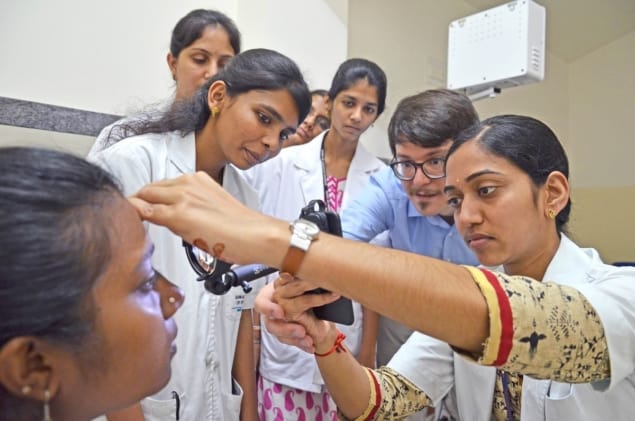
Diabetic retinopathy, a disease of the retina caused by diabetes, is a common cause of blindness in working-age adults worldwide. Early diagnosis and treatment are essential, but millions of people in developing and emerging countries are at risk of impaired sight due to insufficient access to ophthalmic care.
To address this shortfall, the Eye Clinic at University Hospital Bonn and the Sankara Eye Foundation in India have started a collaborative project to introduce unique smartphone-based telemedical screening for diabetic retinopathy. The idea is to use the smartphone’s camera to look into the eye, providing a highly mobile and inexpensive method of fundus photography.
“So far, there have often been no examinations to diagnose diabetic retinopathy in developing and emerging countries,” explains Maximilian Wintergerst, physician at the Eye Clinic of the University Hospital Bonn and director of the project in Germany.
Two years ago, Wintergerst and a team from Sankara Eye Hospital in Bangalore performed a pilot study to test this method of fundus photography. They used retrofitted smartphones to examine 200 patients with diabetes, recording images of patients’ eyegrounds. The smartphones were modified by using an adapter to focus the beam path of the camera and the light source in such a way that the phones function as ophthalmoscopes.
The study showed that ocular fundus examination was possible with all tested smartphone-based procedures. “We therefore have an easily accessible and very cost-effective process,” says Wintergerst.
The smartphone ophthalmoscope can be quickly and easily assembled, enabling trained, non-physician staff to take pictures of a retina, even when they are not within a medical centre. An ophthalmologist can then evaluate images sent from the phone to the hospital, providing immediate diagnosis as to whether the patient has diabetic retinopathy and requires treatment.
Establishing eye screening in India
The project is funded by a two-year grant of around Euro 50,000 from the Federal Ministry for Economic Cooperation and Development and the Else Kröner-Fresenius Foundation. The cash will be used to establish telemedical screening for diabetic retinopathy in poorer districts of Bangalore and surrounding rural areas.
Wintergerst recently visited India to begin training 20 optometrists in smartphone-based funduscopy. He will return several times over the next two years to supervise training at Sankara Eye Hospital and the screening camps. “What is important to us is a sustainable transfer of knowledge so that telemedical screenings can be continued in the long term after the end of the project,” he explains.

Smartphone eye test for the developing world
In addition, six ophthalmologists and employees of the Sankara Eye Hospital will travel to the University Hospital Bonn, where local experts will introduce them to the particular requirements of evaluating fundus images taken with a smartphone and share their know-how on operating a telemedical reading centre.
If all works as planned, Wintergerst plans to extend the diabetic retinopathy screening programme to other hospitals of the Sankara Eye Foundation, with the telemedical reading centre in Bangalore as the coordinating site. The concept could also be transferred to other emerging and developing countries. “This could significantly improve eye care for many people with diabetes, especially in rural areas with poor medical infrastructure,” he says.



